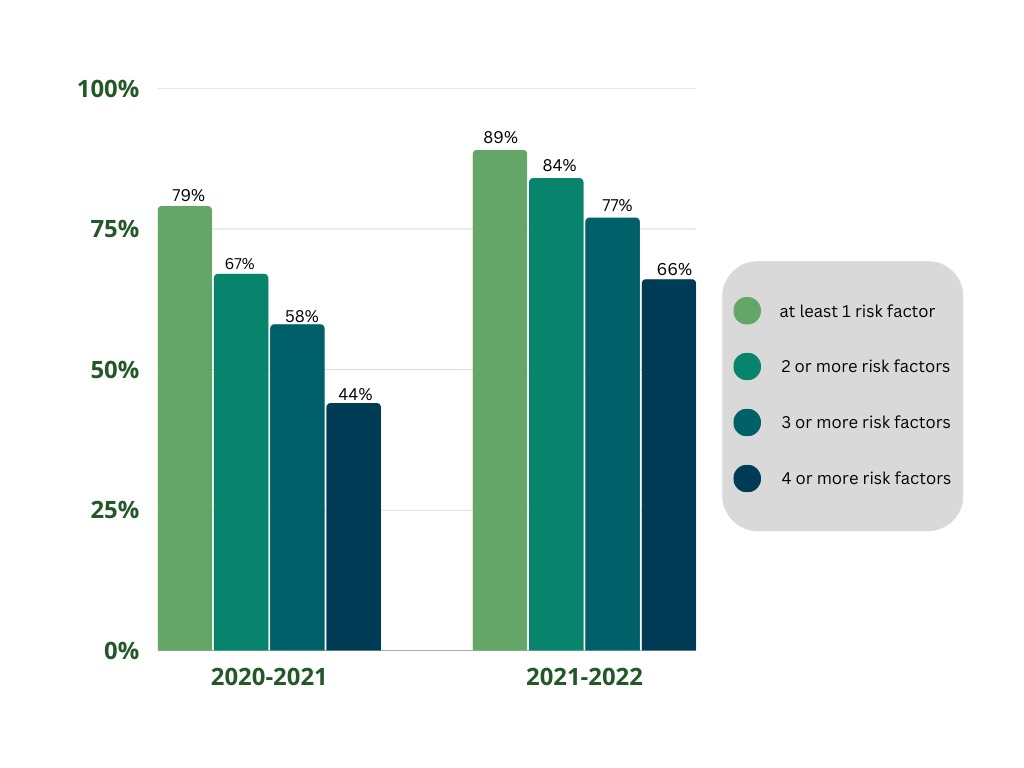Table of Contents
ToggleUnderstanding Domestic Violence Statistics Australia
Domestic violence in Australia is alarmingly common, with numerous cases reported each year. Recent data indicates that a significant percentage of Australian women have experienced physical or sexual violence from a current or former partner.
This statistic is even more concerning when considering the number of incidents that go unreported due to fear or stigma.
The Federal Circuit and Family Court of Australia has stated an increase of reported risk factors in parenting matters from 2021 to 2022.
Key Points:
- There has been a large uptake of parenting matters where parties are claiming either themselves or their children are at risk.
- The Courts initiatives to finalise matters faster has been working.
- Despite this, the influx of reported domestic violence is still on the incline.
The data provided is a shocking revelation showing that there has been a significant increase in the number of parties in the Federal Circuit and Family Court of Australia who allege that there is at least one risk factor present in their case, from 2020-2021 to 2021-2022.
The risk factors present can include child abuse, family violence, drug, alcohol or substance misuse, mental health issues, risk of abduction, and recent threats to harm a child or other person relevant to the proceedings.

From 2020-2021, 79% of parties alleged that there is at least one risk factor present in their case, but in 2021-2022, the percentage of parties alleging the presence of risk factors has increased to 89%.
The percentage of parties alleging two or more risk factors present also increased from 67% in 2020-2021 to 84% in 2021-2022.
Even more concerning is that the percentage of parties alleging three or more risk factors present increased from 58% in 2020-2021 to 77% in 2021-2022 and the percentage of parties alleging four or more risk factors present increased from 44% in 2020-2021 to 66% in 2021-2022
This could be due to an increase in the awareness and reporting of risk factors or an actual increase in the number of cases that involve risk factors.
This data is only reflective of the number of parties who allege the presence of risk factors, and not a confirmation of the actual presence of these risk factors.


What Do the Statistics Say?
According to recent domestic violence statistics Australia, 1 in 6 women has experienced physical or sexual violence by a current or former partner. 1 in 16 men has experienced similar violence.
Additionally, most victims of domestic violence report the perpetrator as being male. 75% of victims report male perpetrators, while 25% report female perpetrators.
The issue of sexual violence is also prevalent in Australia. Overall, 1 in 5 women and 1 in 20 men have reported experiencing sexual violence.
The severity of domestic violence in Australia is further highlighted by the fact that on average, 1 woman a week and 1 man a month is killed by a current or former partner.
These numbers demonstrate the urgent need for action to address domestic violence in Australia and support those who have been affected by this issue.
The Federal Circuit and Family Court of Australia have various initiatives in place that is assisting victims of domestic violence. The Court, which was notoriously slow in its process and releasing of judgments, is making progress in reducing its pending caseload and increasing efficiency.
In the past years, the number of final order applications has decreased by 17% or over 3,600 cases.
Judges in Division 2 have also seen a significant reduction in their workload, with docket sizes decreasing by more than 60% from an average of 330 cases in early 2021 to 135 cases at the end of June 2022.

This progress is thanks to increased support from registrars, who have taken on more responsibilities to help the judges focus on the most complex and serious cases.
As a result, judges are now able to spend more time on trials and writing judgments.
The immense focus on dispute resolution prior to a final hearing has been successful, and the numbers are impressive. Since September 2021, registrars have also successfully resolved more than 4,000 disputes through dispute resolution events, with a 55% settlement rate, including many long-pending and entrenched cases.
In 2020-2021, an impressive 80% of matters were resolved prior to trial, meaning that out of all the cases that came before the court, a majority were able to be resolved without the need for a trial. That’s a great result, showing that the court and parties involved were working hard to resolve disputes and get people out of the court system before expensive and time-consuming trials.
But that’s not all, the court has been able to improve even more in 2021-2022 with an even more impressive 84% of matters being resolved prior to trial.
This is a 4% increase from the previous year, which is a great indicator that the court and parties involved are finding even more effective ways to resolve disputes and avoid trials.

It’s an important achievement that helps to minimize the emotional, financial and time cost for the parties involved and helps to reduce the backlog of cases and the pressure on the court system.
Also read: Pros and Cons of Collaborative Family Law
The State of Divorce in Australia
In 2021, there were 56,244 divorces granted in Australia.
There were 89,164 marriages across Australia.
The median duration from marriage to divorce was 12.2 years, which means that half of the divorces granted in 2021 were for marriages that lasted less than 12.2 years.
The median duration to separation was 8.4 years, which means that half of the couples that divorced in 2021 separated after 8.4 years of marriage.
This suggests that, on average, couples in Australia are separating relatively soon after their marriages.
It’s important to note that the divorce rate, which is the number of divorces per 1,000 people, has been steadily falling over time.
The average divorce rate in 2001 was 2.9 divorces per 1,000 people and it decreased to 1.9 in 2020. However, in 2021, the rate increased slightly to 2.2 divorces per 1,000 people.
This could be due to the impact of the COVID-19 pandemic and the associated stress, financial strains and isolation, which could have had a negative impact on relationships and marriages.
It’s also worth noting that the data provided only reflects the number of divorces granted by the court and not the number of couples who are separated or living apart.
The number of couples living separately without going through the formal process of divorce could be much higher, and it’s important to take that into consideration when analyzing the data.
While the divorce rate has been decreasing over time, it’s important to note that the data for 2021 suggests that the pandemic may have had an impact on the number of marriages that ended in divorce.
It’s important to continue monitoring the data over time to understand the full impact of the pandemic on marriages and divorces in Australia.
Director of Melbourne Family Lawyers, Hayder manages the practice and oversees the running of all of the files in the practice. Hayder has an astute eye for case strategy and running particularly complex matters in the family law system.





1 thought on “Domestic Violence Statistics Australia: Increase of Reported Risks Have Grown in the Family Court in 2022”
Pingback: Building Bridges, Not Walls: The Collaborative Family Law